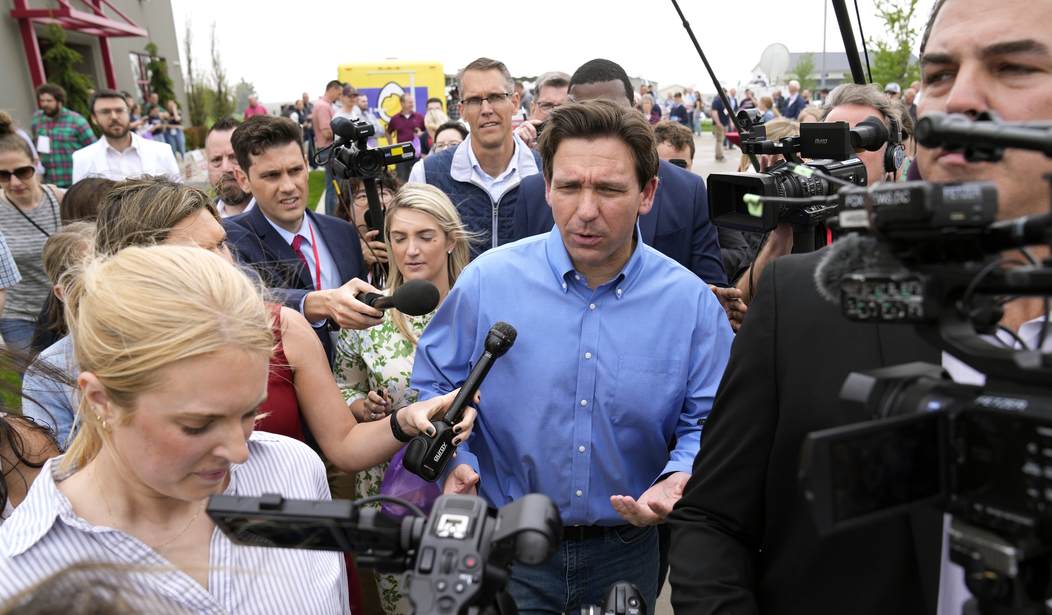DeSantis, you magnificent bastard … you read my book!
Or has he?
Shortly after Ron DeSantis made his official announcement on Twitter Spaces, the New York Times published an in-depth look at his plans to win the GOP nomination. We already knew that DeSantis had close to $100 million left in the bank after his 2022 gubernatorial landslide, and that his allies had perhaps as much or more in their PAC coffers. Not only does that kind of funding offer a huge head start over most of the field (except for Donald Trump), it allows for a wide choice of strategies.
According to the NYT report, DeSantis and his team plan to go grassroots. But do they plan to go granular?
A key political group supporting Ron DeSantis’s presidential run is preparing a $100 million voter-outreach push so big it plans to knock on the door of every possible DeSantis voter at least four times in New Hampshire, Nevada and South Carolina — and five times in the kickoff Iowa caucuses.
The effort is part of an on-the-ground organizing operation that intends to hire more than 2,600 field organizers by Labor Day, an extraordinary number of people for even the best-funded campaigns. …
The group is already taking on many tasks often reserved for the campaign itself: securing endorsements in early primary states, sending mailers, organizing on campuses, running television ads, raising small donations for the campaign in an escrow account and working behind the scenes to build crowds for the governor’s events. Hiring is underway in 18 states and officials said plans were in the works to assemble various pro-DeSantis coalitions, such as for voters who are veterans or those focused on issues like abortion, guns or agriculture.
“No one has ever contemplated the scale of this organization or operation, let alone done it,” said Chris Jankowski, the group’s chief executive. “This has just never even been dreamed up.”
Well, that’s not entirely true. The RNC at least “dreamed it up” in 2013-14 with Reince Priebus’ Republican Leadership Initiative (RLI), and they deployed it in 2016, 2018, and again in 2020 after renaming it the Trump Victory Initiative. But even before that, Barack Obama dreamed it up in 2007 and created an electoral juggernaut that likely saved his presidency in the 2012 election.
At the time, Republicans didn’t understand the scope and depth of what Obama achieved. Most observers either dismissed it as “community organizing,” or just running a Facebook page. Only later did people realize that the Obama team had created not just a voter-turnout machine but a voter loyalty machine, one that made real use of grassroots allies to build personal relationships with voters in each targeted community and precinct, using Facebook and other data to identity influencers to recruit. Obama raised massive amounts of money in order to expand that machine in the 2008 general election, and the loyalty he built with voters allowed him to scrape out a narrow re-election win four years later.
The RLI did a good job of following the mechanics of Obama’s innovative organization. Oddly, the Democrats never did do so, nor even attempt it. The GOP made good use of their organization and succeeded in vastly outdoing the Biden campaign on doorknocking, but it didn’t end up succeeding. Those efforts are worthwhile and have a value to them, but the GOP didn’t use the mechanics in the same way Obama did, and Trump never did adopt that kind of granular approach to campaigning. He preferred sticking with his core talent for big rallies, which provided a stark contrast to Biden’s basement campaign — but not enough to win that way either, not even with the RLI running in parallel to it.
That brings us to DeSantis and the Never Back Down plan. It is unprecedented for a Republican presidential candidate to build and launch this kind of organization, and it will have enormous potential. The question will be what DeSantis and his team plans to do with it. If it’s just door knocking and passing campaign materials around to voters, well, that’s going to help, but as we saw in 2020, it may not be enough.
This was the point I emphasized in my book Going Red. Obama used his massive and expensive organization to listen as well as talk. His team used their local contacts to find out what moved voters in their local communities, and then contextualized their agenda specific to those voters. In my chapter about Tampa, for instance, I offer an example of a neighborhood with poor streets and dead street lights, which the Obama campaign used to craft an argument that their agenda to boost funding for cities would specifically deal with that street — and it did.
If DeSantis builds up that kind of bidirectional communication through this organization, he could be unstoppable. If he’s just counting door knocks, as Republicans did, it adds turnout value but otherwise it’s a wasted opportunity.
One final point to make about this plan: it sets up a very clear contrast of styles between the presumed frontrunners. Trump has been and will use his rallies and earned media to garner support through the force of his personality, while DeSantis will use a more traditional grass-roots method that has less flash but more depth. Trump has never ran against a field operation like this, not even in 2016 against Hillary Clinton. And when it comes to caucus states, Trump will start off at a huge disadvantage against a campaign organized like this.
If Republican primary voters make their decision based on who’s more prepared to fight in a general election, they may decide on the candidate who’s already built an election machine — and hopefully a lot of brand loyalty for the party. It’s a dynamic worth watching, and one that polls will miss for a while.







Join the conversation as a VIP Member